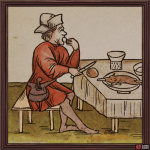Text
In the Middle Ages, both in villages and at royal courts, primarily locally available foods were used. Vegetables included cabbage, onions, parsnips, turnips, beets, garlic, with smaller quantities of carrots, celery, parsley, cucumbers, and melons. Legumes such as peas, lentils, vetch, and broad beans were common, alongside fruits like apples, pears, cherries, plums, berries, nuts, seeds, and grains. ![]() Eggs, milk, and cheeses were available year-round.
Eggs, milk, and cheeses were available year-round.
Depending on wealth, availability, and the season, meat (game, poultry, fish) and imported goods like spices, fruits, and delicacies such as saffron, dates, figs, nutmeg, pepper, sugar, ginger, and cardamom were also consumed. Meals were seasoned with oils, vinegar, salt, honey, and herbs.
The most popular dishes in the 14th and 15th centuries, especially in rural areas, were hearty soups, thickened porridges, and sauces served with bread. Rye bread was common, while white bread was reserved for the court. Meat was expensive, and hunting in forests (reserved for nobles) was prohibited, so fish often compensated for its scarcity.
During a sumptuous feast, dishes featuring fish like pike, various roasted meats, sausages, minced meat, black pudding, and legumes were essential. Desserts included almonds, marzipan, sweet porridges with fruit cooked in milk or with added cream, jams, baked, raw, and dried fruits, and assorted pastries.
In the Middle Ages, many of today’s common ingredients were unavailable, such as potatoes, tomatoes, corn, peppers, rice, or beans, which generally arrived in Europe only after the discovery of the Americas or through Asian imports.


No Comments